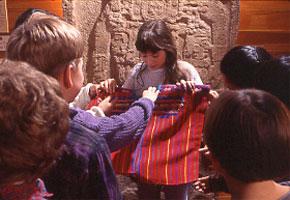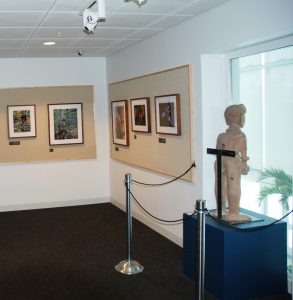Group Sizes and Fees
 Minimum group size is 10. Tour group size for individual tours is 25 however, we can accommodate group sizes up to 75 students at a time. There is a charge of $3 per student. School groups should be accompanied by one adult (admitted free) for every 10 students. For accommodations for persons with disabilities, please call: 207.581.1906. For information about how the Hudson Museum supports teaching Wabanaki history and culture in the classroom, visit our Wabanaki Study Unit.
Minimum group size is 10. Tour group size for individual tours is 25 however, we can accommodate group sizes up to 75 students at a time. There is a charge of $3 per student. School groups should be accompanied by one adult (admitted free) for every 10 students. For accommodations for persons with disabilities, please call: 207.581.1906. For information about how the Hudson Museum supports teaching Wabanaki history and culture in the classroom, visit our Wabanaki Study Unit.
We offer Tours Monday through Friday (excluding Holidays) between 9 and 3. We have many commitments for the museum space and receive many tour requests during the school year, so please provide us with multiple days and times you can visit so we can best accommodate you.
Programs and Tours
The Hudson Museum offers guided tours and gallery programs for elementary and secondary school groups, as well as programs for University students and learners of all ages. Additionally, we offer programs that support state mandated educational initiatives.
To book a tour at the Hudson Museum, please fill out the online form or download the Tour Request Form (PDF) and contact Kelly Hoover at 581-1906 or by email at kelly.hoover@maine.edu at least two weeks prior to the desired tour date to ensure convenience of scheduling.
All groups coming to the Museum must call the Museum office prior to their visit to confirm space and schedule availability.
Bus Arrival Information: Buses should arrive on campus at least 10 minutes prior to the group’s tour time.
From the South:
From I-95, take exit 191 to Kelly Road and turn right.
From the North
From I-95, take exit 191 to Kelly Road and turn left.
Continue on Kelly Road for 1 mile until you reach the traffic light, then turn left onto Route 2 and go through downtown Orono. Cross the river, then bear right onto Park Street. Continue .5 miles and take the Rangeley Road exit from the traffic circle onto the University of Maine campus. At the fork in the road, bear left and proceed toward the Memorial Union circle. All school buses unloading passengers for Hudson Museum tours should pull up along the fire lane by the Class of 1944 Hall, unload onto the sidewalk next to our main entrance, and follow the sidewalk to our glass atrium/lobby. The buses should then make the loop by the Memorial Union and park at the Hilltop parking lots until the program is over.
*Updated as of 11.16.23
Tour and Gallery Program Information
Adventures in Anthropology Program
Using objects in the museum’s World Cultures Gallery, students will explore aspects of culture, including writing systems, foodways, and transportation. They will also explore how the environment, natural resources, and cultural preferences impact the types of houses cultures create. Figure out who lives in a wigwam, yurt, igloo, stilt house, or a house made from adobe bricks–and why. Match forms of transportation with how they are powered. Explore plants and animals from around the world, figure out where they came from and how they have been integrated into our diet. Try your hand at using masks to tell a story.
Wabanaki Program
Learn about the material culture of Maine’s four tribes, focusing on basketry, birchbark work, decorative and carving traditions. Your program may include traditional Penobscot legends or interviews with Wabanaki basketmakers, carvers, birchbark and beadwork artists. Activities for this tour are age-appropriate and allow students to try their hand at playing Waltes, a traditional bowl game, making a “birchbark” container or a Northeastern decorative bag.
Native American Program
This program focuses on the Native Peoples of Maine, the Southwest, the Northwest Coast and the Arctic. Learn about the environments in which they live, their way of life through the objects that they make, and traditional artforms and activities.
Mesoamerican Civilizations Program
Learn about the civilizations–Olmec to Aztec–of Mesoamerica through artifacts from the Hudson Museum’s collection. This program is geared to middle school students.
Wabanaki Native Voices Videos Online
New Web-based Educational Resources to support the teaching of Wabanaki History and Culture. The video segments that are featured in the Wabanaki Gallery’s Native Voices kiosks are available for use in your classroom now.

